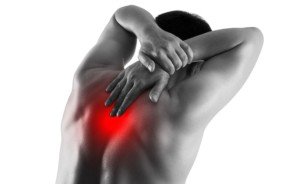
Blocked arteries can cause back pain and so can strained muscles; unfortunately the pain from both can feel very similar.
However, there are clues…
“It’s not always easy to differentiate between angina back pain and musculoskeletal back pain, but there are clues,” says Charles C. Cummings, MD, Interventional Cardiologist, LifeBridge Health Cardiovascular Institute in Baltimore, MD.
How to Tell Difference Between Angina Back Pain and Muscle Back Pain
Dr. Cummings explains, “For example, if you put your arm in one specific position and it causes pain, but in another position, the pain completely goes away, it’s less likely to be a cardiac issue.
“Also, if you press on the same area of your chest or arm and it hurts, but it goes away when you stop, that’s more likely to be musculoskeletal…not 100 percent but more likely.
“Another example of pain that can be cartilage-related and not angina can be with people who have arthritis who move into a certain position and can duplicate the pain and stop it when they change positions.”
Whether the pain in one’s back is one-sided or seemingly equal on both sides is not indicative of likelihood of a heart problem.
Furthermore, muscle related strains or pulls may be one-sided or bilateral.
Got “Costo”?
“Additionally, there is a condition called costochondritis,” continues Dr. Cummings.
This condition, which many bodybuilders and muscle-building athletes are familiar with, “is inflammation in the joint between the sternum and the ribs that causes pressure which is not cardiac related.”
The discomfort is typically in the chest but can affect the back.
Spasms
“Another atypical type of angina is called Prinzmetal angina,” says Dr. Cummings.
“This is when there is a coronary spasm that’s not from a fixed blockage from arteriosclerosis (also called hardening of the arteries).
“This type spasm frequently happens at night when someone is lying down, and all of a sudden, he or she experiences severe pain. Prinzmetal angina is relatively rare compared to the typical angina.
While the above examples may not be [typical; clogged arteries] angina, without proper testing, there is no way to be absolutely certain.”
Physical Exertion Is Very Telling
Dr. Cummings explains, “What is more certain is that when individuals have chest, shoulder, arm or back pain while exerting themselves, that’s more typical of angina.

Shutterstock/MikeSaran
“Additionally, if someone is sitting down, completely relaxed and has chest pain, that could be an indication of a severe blockage to the heart, and if it gets worse, the artery may be very severely blocked.”
This is called unstable angina and is a very serious condition that needs immediate medical attention.
If you’re an athlete who’s been getting along fine and have had your share of musculoskeletal back pain, but this time the issue seems to have no traceable cause, you should get your heart checked out just to play safe.
Musculoskeletal back pain that does not involve cartilage or tendons – just the muscle as far as soft tissue – should begin resolving soon after avoiding the suspected offending activity such as overdoing it with the deadlifts.
Muscle related back pain, including in the upper region, can be quite painful, and depending on the mechanism of injury and type of injury, can take weeks to subside.
This type of pain is very responsive to movement, though may still hurt when you’re sitting still. Slight movements can set it off.
This descriptor of the back pain points heavily towards a musculoskeletal cause rather than angina.



























